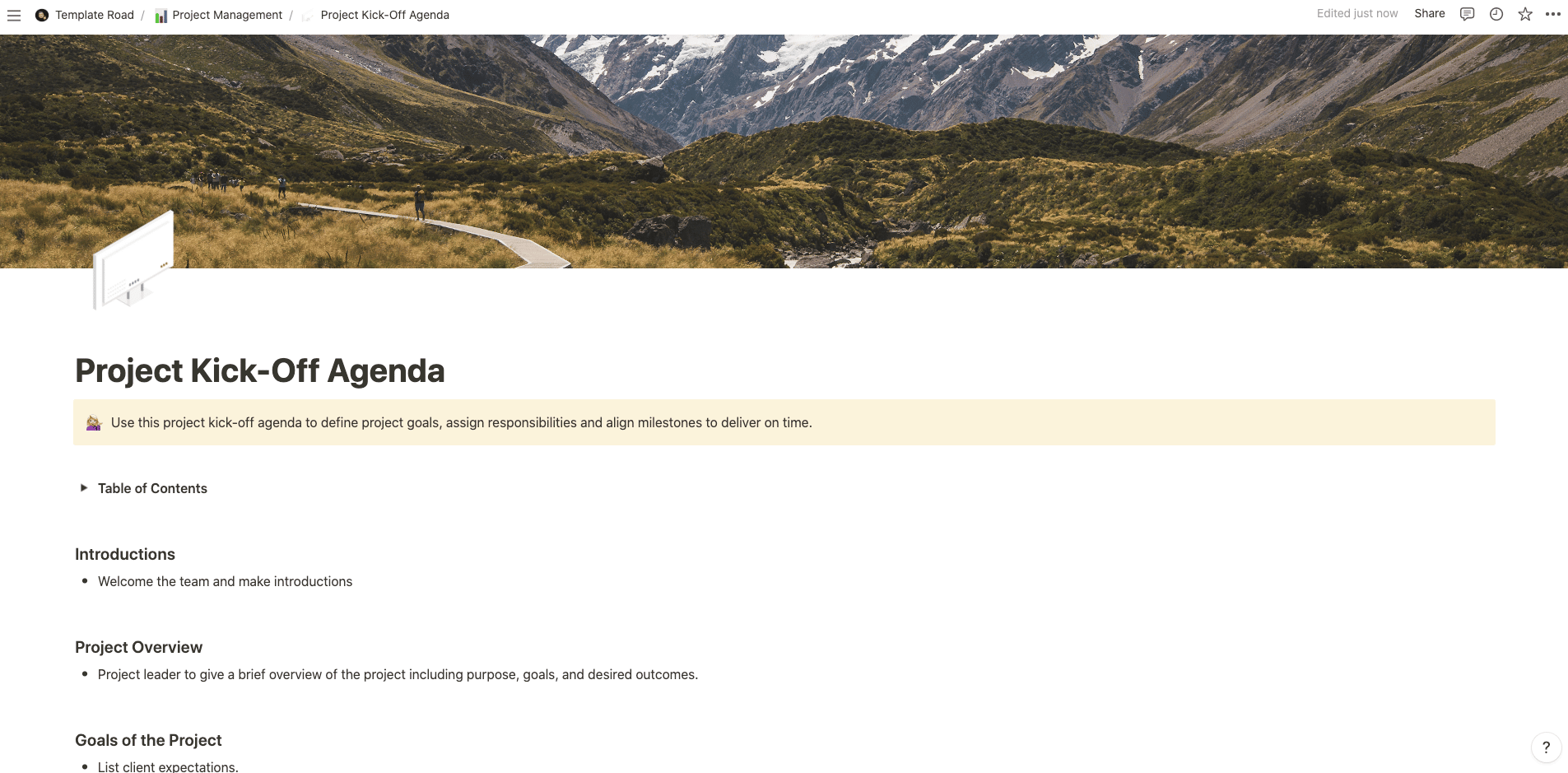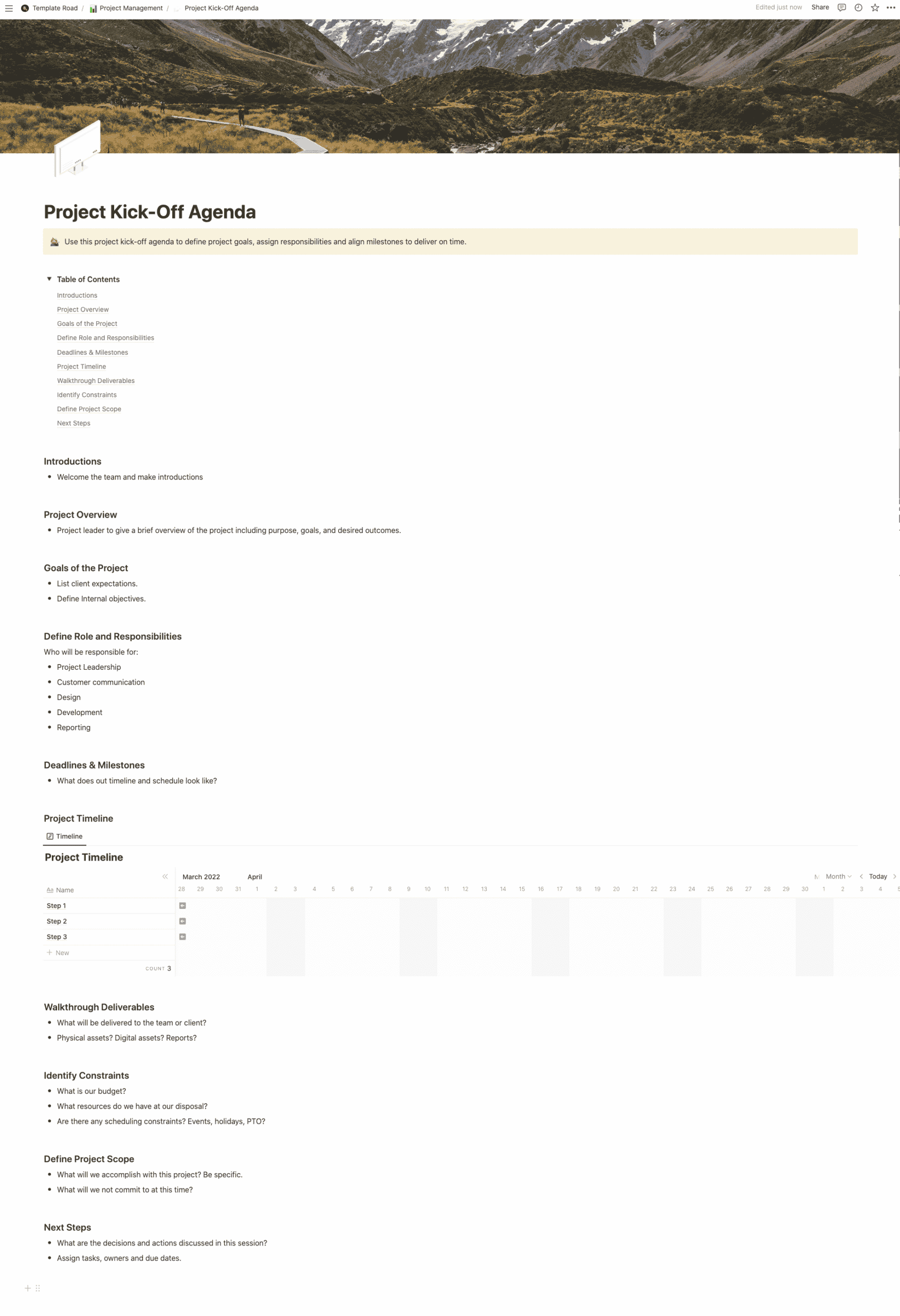A project kickoff meeting is the first step towards a successful launch. Teams who follow a structured process have better planning and meet deadlines on time and under budget – so gather your team and use our kick off meeting agenda template for your upcoming project.
Buy on
Notion – Project Kickoff Agenda Template
$7
Contents
- Notion – Project Kickoff Agenda Template
- How to Run Effective Project Kickoff Meetings
- 1. Start Early
- 2. Make Sure Everyone Is On Board
- 3. Have Clear Goals & Expectations
- 4. Keep It Short
- 5. Be Flexible
- 6. Use Visual Aids
- 7. Set Up a Checklist
- 8. Plan Ahead
- 9. Provide Feedback
- 10. Follow Through
- Planning your project kick-off meeting
- Define the Project Scope
- Identify Stakeholders
- Gather Requirements
- Develop a Project Plan
- Create a Scope Statement
- What’s the difference between a project kick-off meeting with your team and with customers or clients?
Notion – Project Kickoff Agenda Template
This template is perfect for organising your project kickoff meetings. The project kickoff meeting is the beginning of a project where all of the stakeholders get together to discuss the foundation of the project, what needs to be accomplished, and who is going to accomplish which tasks. The kickoff sets the tone for the whole project so it’s important to get it right. There’s a lot of ground to cover in this first meeting to make sure that each person understands where you’re going and how you’re going to get there.
——————————————-
What you need before purchase
- Basic knowledge of how to use Notion
- Paid Notion account if you’ve looking to add lots of content to your template / Notion account (sign up here). Not much content? You’re able to use their free account.
——————————————-
After purchase
After purchase, you’ll be able to view the template immediately. The template can be added to your Notion account by:
- Click on the template download link in Gumroad
- When viewing the Notion template, click on the “Duplicate” link in the top-right of your screen
- The template will now be available in your own Notion account
For ongoing use, the steps are:
- Login to Notion and select the template you want to view
- Click on the Duplicate link in the top-right of your screen to create a copy to use
- You’ll be able to retain the Notion template and work on the Duplicate (with a new name) and can repeat this process whenever you want to use the template again
How to Run Effective Project Kickoff Meetings
Project kickoff meetings are a great way for your team to get started on the project. They can also be used as an opportunity to introduce new people and help them understand what’s going on with the project. But they can also be a time of stress, anxiety, and confusion if not done well. So how do you run effective kickoff meetings? Here are some tips:
1. Start Early
Start planning your kickoff meeting at least two weeks before it is scheduled so that everyone has enough time to prepare. This will give you time to make sure all the necessary materials are available and to set up any presentations or other activities. It will also allow you to plan out the agenda and have plenty of time to review it with each person in advance.
2. Make Sure Everyone Is On Board
Make sure that everyone who needs to attend the kickoff meeting is aware of it. If someone isn’t interested in attending, let them know early so they don’t feel pressured into coming. You may want to send a reminder email about a week before the kickoff meeting.
3. Have Clear Goals & Expectations
Set clear goals and expectations for the kickoff meeting. For example, you might say something like “We’re here today to discuss our project’s scope, schedule, budget, and deliverables. We’ll start by reviewing the project charter and then we’ll move onto discussing the project timeline.”
4. Keep It Short
Keep the kickoff meeting short. Don’t try to cover everything in one meeting. Instead, break down the topics into smaller chunks and hold separate meetings for each topic.
5. Be Flexible
Be flexible when things go wrong during the kickoff meeting. If there are problems with the schedule, budget, or deliverables, address those issues immediately. Then continue with the rest of the meeting.
6. Use Visual Aids
Use visual aids such as flip charts, whiteboards, and overhead transparencies to keep track of information. Also use sticky notes to highlight key points.
7. Set Up a Checklist
Have a checklist ready ahead of time to ensure that you’ve covered everything. Include items such as:
- Reviewed the project charter
- Discussed the project scope
- Identified the project stakeholders
- Gathered input from the stakeholder groups
8. Plan Ahead
Planning ahead helps prevent last-minute surprises. Before the kickoff meeting, identify potential issues and questions that could arise. For example, you could ask “What should I expect from the stakeholders?” or “Who else needs to be involved?”
9. Provide Feedback
Provide feedback after the kickoff meeting. Ask participants what worked well and what didn’t work so well. What did they learn? How can you improve next time?
10. Follow Through
Follow through on the actions taken during the kickoff meeting. For instance, if you identified a problem area, follow up with the appropriate people to see if they need additional resources or training.
Planning your project kick-off meeting
Kick off your project with a kickoff meeting. The kickoff meeting is an important step in the project life cycle because it sets the stage for the entire project. During this meeting, you’ll get to know your team members, define the project scope, develop a project plan, and gather requirements. The kickoff meeting is typically held no later than three months before the project begins. However, depending on the size of the project, you may have more time to prepare. You’ll probably meet at least once before the kickoff meeting. This initial meeting will help you determine whether the project is feasible and whether you’re prepared to begin working together. The kickoff meeting usually lasts between two and four hours. Depending on how much time you have, you may choose to split the meeting into multiple sessions.
During the kickoff meeting, you’ll review the project charter, which defines the purpose of the project, identifies the project stakeholders, and outlines the project scope. You’ll also discuss the project schedule, budget, and other details. To set clear expectations for the kickoff meeting, you must first understand the project objectives. These objectives include defining the project scope, identifying the project stakeholders, gathering requirements, developing a project plan, and creating a timeline.
Define the Project Scope
Before you start planning the kickoff meeting, you should clearly define the project scope. This includes determining the following:
- Who’s going to do what
- When the project starts and ends
- Which tasks are included in the project scope
- What the project goals are
Identify Stakeholders
To effectively manage a project, you must know who’s responsible for each task. In addition, you must communicate with all relevant parties throughout the project. For example, if you’re managing a construction project, you might want to involve the architect, contractor, owner, and subcontractors. If you’re managing a software development project, you’d likely want to involve the client, developer, and end users. Include everyone who has a stake in the project. This includes both internal and external stakeholders. Internal stakeholders include those within your organization who are directly affected by the project. External stakeholders include anyone outside your organization who has a stake in its success. For example, if you’re building a new office building, you would include the architects, contractors, and engineers. If you’re designing a website, you’d include the web designer, developers, and clients.
Gather Requirements
After you’ve identified the stakeholders, you need to collect their requirements. A requirement is information that helps you complete a specific task or deliverables. Requirements can be anything from a list of features to a detailed description of a product. They can even be as simple as a request for clarification about a particular aspect of the project. Collecting requirements is an important part of the kickoff meeting because it allows you to create a shared understanding of the project. It also ensures that everyone involved understands the project scope and what they need to accomplish during the project.
Develop a Project Plan
Once you’ve collected requirements, you’ll use them to develop a project plan. The project plan describes the activities that will take place over the course of the project.
The project plan includes the following components:
- Work breakdown structure (WBS)
- Schedule
- Milestones
- Budget
- Resources
A WBS breaks down the work into manageable chunks so that you can easily identify the work that needs to get done. For example, if you’re working on a website redesign, you could break down the project into the following categories:
- Design
- Development
- Testing
- Deployment
A schedule defines when each activity will occur. You may have one schedule for the entire project or multiple schedules based on the phases of the project. Milestones represent key points along the way. Each milestone represents a significant achievement toward completing the project. A budget identifies how much money you expect to spend on the project. Resources describe the people, tools, equipment, and other resources needed to complete the project.
Create a Scope Statement
You should always start any project with a clear definition of what you’re trying to achieve. That means defining the problem you’re solving before you begin developing solutions. This process is called scoping. Scoping involves creating a statement that clearly defines the purpose of the project. It’s critical to define the scope early in the project because it helps you avoid wasting time and energy on projects that aren’t aligned with the business goals. If you don’t do this upfront, you risk spending too much time and effort on something that doesn’t solve the real problems.
Here’s an example of a good scope statement:
“We are looking to increase our conversion rate by 10 percent.”
In addition to helping you focus your efforts, a well-defined scope statement also provides a basis for measuring success. This makes it easier to determine whether the project was successful.
What’s the difference between a project kick-off meeting with your team and with customers or clients?
Kickoffs with your team are usually focused on getting the ball rolling on the project. Kickoffs with clients or stakeholders are more formal and involve gathering information about their expectations and concerns. Both types of meetings are equally important. However, you might find yourself doing both at different times throughout the project. For example, you might hold a kickoff with your team first to help them understand the project and then follow up with a stakeholder meeting later in the project to gather feedback.















